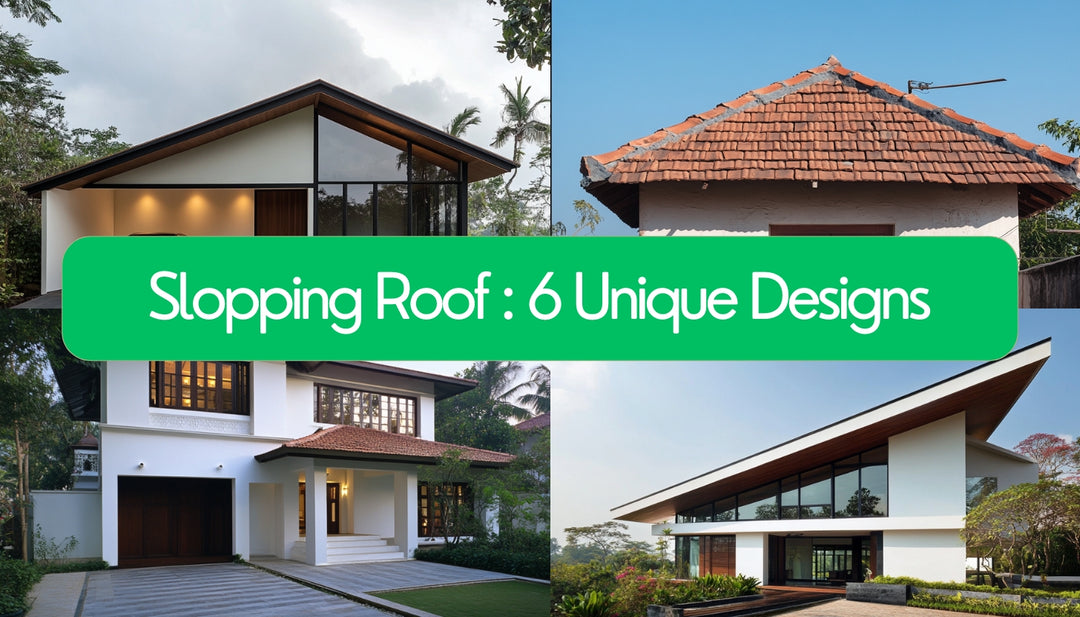Innovative Vertical Gardens in Indian Homes - Conquer Space with Architect’s Guide
 With urbanisation on the rise, home spaces in Indian cities are shrinking. Yet our longing for greenery persists. Vertical gardening presents a scientific solution to bring luscious greens into compact urban homes.
With urbanisation on the rise, home spaces in Indian cities are shrinking. Yet our longing for greenery persists. Vertical gardening presents a scientific solution to bring luscious greens into compact urban homes.
Integrating vertical gardens allows you to transform even the tiniest apartment into an indoor oasis. You can infuse bare walls with life, cultivate healthy herbs, beautify balconies, bask under flowering climbers, and enjoy nature's therapeutic effects.
This guide dives into the architectural considerations and horticultural science behind crafting thriving vertical gardens. Whether you want a living wall, hanging balcony garden, or modular setup, we cover beginner-friendly techniques for Indian spaces and climates.
Ready to let your inner architect bloom? Let's explore the innovative world of vertical gardens!
Understanding the Science Behind Vertical Gardens
 Crafting living walls requires strategic plant choices and growing methods. What environmental factors affect indoor gardens? How do you provide nutrients without soil? Let's dig into the science.
Crafting living walls requires strategic plant choices and growing methods. What environmental factors affect indoor gardens? How do you provide nutrients without soil? Let's dig into the science.
Photosynthesis and Plant Growth Requirements
Photosynthesis allows plants to convert light into energy and carbon dioxide into oxygen. For this process, plants need:
- Light: Both indoor and outdoor vertical gardens need adequate sunlight or supplemental lighting for photosynthesis. Light levels and duration impacts growth rates.
- Water: A hydroponic system provides moisture along with essential nutrients to plant roots. Water requirements vary across plant species.
- Air circulation: Air movement around foliage facilitates gas exchange critical for plant health. Strategic spacing and ventilation prevents mould.
- Ideal temperatures: Warm seasons promote faster growth for most garden plants. Consider seasonal microclimates in vertical garden design.
Getting these scientific factors right allows your vertical garden to thrive beautifully!
Hydroponics vs Aeroponics: Soilless Growing Systems
While traditional gardening relies on soil, vertical systems utilise advanced hydroponics and aeroponics techniques for soil-less cultivation.
Hydroponics involves growing plants in nutrient-rich water solutions rather than soil. The water delivers essential elements like nitrogen, phosphorus, potassium directly to roots. Popular hydroponic techniques include:
- Deep Water Culture (DWC)
- Nutrient Film Technique (NFT)
Aeroponics is an advanced technique where plant roots hang in air while getting misted with a nutrient solution. This oxygen-rich environment facilitates rapid growth.
Choosing a hydroponic growing system with the right nutrients levels prevents deficiencies and unlocks up to 20% faster plant growth than soil growing. It allows healthy plant cultivation even in space-constrained vertical gardens.
Microclimates and Environmental Factors in Indian Homes
When creating indoor vertical gardens, pay special attention to lighting and ventilation. Judiciously utilise skylights, glass windows and analyse sunlight patterns across seasons.
Outdoor vertical gardens can leverage local microclimates around Indian urban homes. Analyse sun, wind, humidity patterns on your terraces, balconies, and exteriors. North-East facing walls work well in most regions.
Select plants suited to lighting, ventilation, and climatic conditions in your vertical landscape. Let your architectural insights nourish a flourishing vertical oasis!
Techniques for Creating Vertical Gardens in Indian Homes
From lush living walls to modular balcony gardens, here are DIY-friendly techniques suited for Indian spaces.
Living Walls: A Lush Green Tapestry for Your Interior
Transform bleak walls into an indoor foliage spectacle! Living walls utilise vertical hydroponic systems to cultivate plants on structures like concrete, PVC boards, welded mesh, or coco fibre mats.
Drip irrigation systems and grow lights nourish plants. You can install living walls indoors and outdoors to enhance visual appeal. They also improve air quality and insulation.

Image credit: Floreasca Park, Bucharest Photographer: Delphi Romanian
While complex designs need expert installation, you can create simple living walls with affordable DIY techniques:
- Hang pre-planted modular boxes on a wall mounted rail system
- Arrange air plants artistically on a vertical manzanita branch installation
- Craft a small living wall easily using reused plastic bottles!
Unleash your creativity for stunning living wall displays anywhere from window corners to stark staircase walls.
Green Facades: Transforming Exterior Walls into Vertical Gardens
Green facades refer to exterior vertical greenery systems, most commonly climbing plants. You can train vining ornamental plants with tendrils, stiff stems, adhesive pads or clasping aerial rootlets against walls. Metal wire trellises, meshes and frames provide support.
Benefits:
- Enhances building aesthetics
- Provides flower displays
- Lowers wall temperature and noise
- purifies outdoor air
Plant options:
- Passion flowers
- Climbing roses
- Jasmines
- Creepers like ivy, money plant
Add colour to boring walls, camouflage eyesores like drain pipes, or just enjoy blooming climbers outside your window!
Modular Systems and DIY Options for Adaptable Vertical Gardens
Don't want to customise an entire wall? Modular planters offer flexibility. You can install ready vertical garden systems outdoors on fences, balconies, and rooftops or movable indoor units.
Commercial modular systems come with integrated irrigation, drainage, and grow lights. Many models even have auto-watering and hydroponics!
You can also DIY modular planters economically using recycled containers. All you need are stacking crates, pipes, old bottles or roof gutters! Grow herbs, leafy greens, strawberries and flowers in your custom soil-based planters.
Get creative with modular container combinations to design adaptable vertical gardens!
Plant Selection for Indian Climate and Urban Environments
Choosing the right plants can make or break your vertical garden's success. Here are hardy plant picks suited for Indian city conditions:
Herbs: Mint, curry leaf, thyme, parsley, oregano, rosemary
Food crops: Chili peppers, eggplants, cherry tomatoes, strawberries
Flowers: Marigolds, portulaca, zinnias, daisies
Some plants like spider plants, pothos, ferns are natural air purifiers! For indoors, pick shade-loving low light options. Outdoors, select resilient plants for seasonal climate variations.
Now take your vertical gardening to new heights with help from architectural optimization for lighting, irrigation, and airflow!
Architectural Considerations for Vertical Gardens
Careful planning is key to creating thriving, sustainable vertical gardens tailored for urban Indian spaces.
Space Optimization and Structural Integration
As an architect, meticulously evaluate available vertical surfaces on walls, fences and balconies. How much load can these structures support? Sunlight, ventilation and access needed for maintenance should also inform design.
Get creative in stacking modular planters, angling panels, or alternating plants for dense green facades without compromising health. Structurally integrated living walls using moisture barriers and rainwater collecting reservoirs.
Optimising capacity while keeping installations safe, accessible and appealing is crucial.
Water Management and Irrigation Systems
Since vertical gardens cannot rely on natural soil drainage and rainfall, effective irrigation is vital. Drip systems with timers conserve water while recirculating excess.
Use level controllers to create ebb and flow for hydroponic planters. Waterproof ultraviolet-resistant pipes. Install submersible pumps in reservoirs.
Automatic, self-watering systems are emerging for efficient hydroponic vertical gardens, allowing vacation carefree maintenance. You can even monitor moisture with sensors!
Lighting and Artificial Light Sources for Indoor Gardens
While outdoor vertical gardens leverage sunlight, supplemental lighting is essential for indoor living walls to facilitate healthy photosynthesis.
Analysing sunlight exposure across seasons informs growth of light needs. Full spectrum LED grow lights spaced optimally can nourish plants indoors.
You can even leverage innovative light-transmitting optical fibres integrated into vertical panels! Proper lighting and backups prevent etiolation and drought damage.
Maintenance and Upkeep Strategies for Vertical Gardens
Pruning, cleaning, replanting, and equipment checks are vital for lasting appeal. Outdoor gardens need monsoon protection.
Test water quality and nutrients in hydroponic systems. Watch for disease and pests. Strategically placed vertical gardens utilise natural light while easing upkeep.
You can safeguard investments via weatherproof casings and wind barriers. But remember, sustained effort is key for nurturing your vertical Eden!
Benefits of Vertical Gardens for Space-Constrained Homes
Beyond captivating aesthetics, vertical gardens promise:
Increased Greenery and Improved Air Quality
Mask concrete jungles with abundant verdure via vertical gardens! More foliage improves air quality by:
- Increasing oxygen through photosynthesis
- Absorbing air pollutants like VOCs (benzene, formaldehyde) emitted indoors and dangerous PM2.5 particulates from traffic outdoors
- Releasing moisture to moderate humidity naturally
- Respire calming phytoncides from plants like spiderworts
Breathe easy with living air filters flourishing on your walls for better health!
Enhanced Aesthetics and Visual Appeal
Infuse bleak spaces with life! Vertical gardens let you design stunning arrangements using diverse colours, textures, scents. They lend visual depth via strategically interplaying forms along narrow facades.
Frame views, hide eyesores, or just enjoy charming blooms against your balcony. Creative trellising enhances architectural facets with lush cascading foliage or geometric patterns.
Uplift any space with gorgeous vertical greenery vistas.
Reduced Noise Pollution and Thermal Insulation
Strategically placed vertical plant facades absorb urban sounds. The foliage layers also insulate against temperature fluctuations, cutting air conditioning expenses.
Living walls keep building interiors cooler in summers and warmer in winters for up to 30% savings in cooling/heating costs in tropical climates like India!
Sustainable Food Production and Edible Gardens
Elevate patio-farming with stacked hydroponic planters tailored for edibles! Apartment dwellers can grow their own fresh herbs, vegetables, strawberries and benefit from:
- Lower food miles: Higher yields compared to traditional horizontal farming reduce carbon footprint from long-distance transport.
- Pesticide-free nutritious produce from controlled indoor settings
- Lower water usage than conventional soil farming through precision irrigation
Even tiny spaces can become lush edible oases!
Psychological Benefits of Nature Connection in Urban Spaces
In bustling chaotic cities, vertical gardens grant high-rise occupants access to stress-relieving nature views and cleaner environments linked with:
- Improved mental health: Lower anxiety and depression
- Increased workplace productivity and creativity
- Faster patient recovery when integrated in hospitals
- Property value appreciation from upscale architecture blending nature and cutting edge technology
When thoughtfully incorporated, vertical gardens enhance wellbeing beyond measure in built-up areas.
So transcend space constraints and immerse in abundant greenery for better living!
Conclusion: Let Your Vertical Gardens Flourish!
Vertical garden systems leverage horticultural science and architectural optimization for bountiful greenery even in space-starved urban areas.
Sustainable food production, living air purifiers, cooler interiors, and calming aesthetics represent just some benefits of embracing vertical gardens tailored for Indian residences and climates.
This guide covered DIY-friendly techniques like living walls, green facades and modular gardens thriving through hydroponics. We analysed site-specific considerations around lighting, irrigation, structural load bearing capacity and plant selections.
Ready to unleash your inner architect-gardener? Start small by brightening up an empty corner with air plants or installing modular balcony planters. Slowly integrate vertical landscape elements customised for your space and vision.
Soon you can host birds among fruiting vines on your pergola, enjoy fresh mint tea from your modular herb tower, or just unwind gazing at your living wall tapestry.
So why wait? Go green vertically and enrich any space with nurturing nature today!











Would like to get this wall in my home. Pls send contact details
Leave a comment